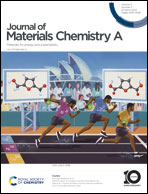B-site mixed cationic tetrahedral layer confined the concentration and mobility of interstitial oxygen in mellite family†
Abstract
Melilite-type oxide ion conductors usually were observed in pure gallate compounds. Here a new mellite interstitial oxide ion conductor Ca2−xLaxGa2GeO7+x/2 (0 ≤ x ≤ 0.15) was developed by the substitution of La3+ for Ca2+ in Ca2Ga2GeO7 containing mixed GaO4/GeO4 tetrahedral layers. Neutron powder diffraction data indicated that the introduced interstitial oxide ions were accommodated in the distorted pentagonal rings, close to the coordination environment of (Ga2/Ge)O4 containing terminal oxygen. Defect formation energy calculations further reveal that the interstitial oxygen not only favors to approach the GaO4 tetrahedra, in agreement with studies of other pure gallate systems, but also is confined to the GeO4 tetrahedra. Bond-valence-energy landscape calculations and molecular dynamics simulations revealed that the interstitial oxide ions were transported among the pentagonal rings within the tetrahedral layers through a cooperative mechanism involving the synergistic knock-on motion between interstitial and framework oxygens. In Ca2Ga2GeO7, the La3+ substitution for Ca2+ only extended up to x = 0.15, which is much lower than those in the La–(Ca/Sr/Ba) based gallate mellites. The x = 0.15 composition resulted in oxide ion conductivities ∼2.79 × 10−5 S cm−1 to 1.68 × 10−3 S cm−1, with oxygen transport numbers of ∼92.65%, two orders of magnitude higher than that of the parent material. However, compared with pure gallate melilite interstitial oxide ion conductors with the same interstitial oxide ion concentrations, Ca1.85La0.15Ga2GeO7.075 has about one order of magnitude lower conductivity. The lower interstitial oxide ion concentration and conductivity in Ca2−xLaxGa2GeO7+x/2 reveal that although Ge4+ has similar chemical properties to the adjacent Ga3+, the subtle differences in size and the resultant covalent bonding ability make the mixed GaO4 and GeO4 tetrahedral layers in mellite unfavorable for accommodation and transportation of interstitial oxygens.



 Please wait while we load your content...
Please wait while we load your content...